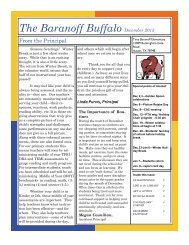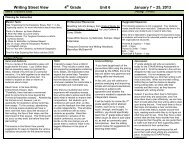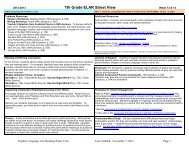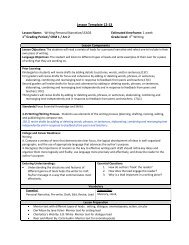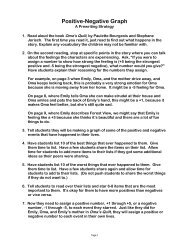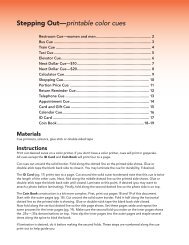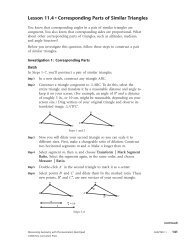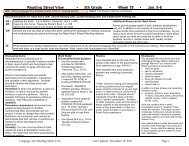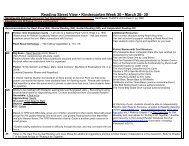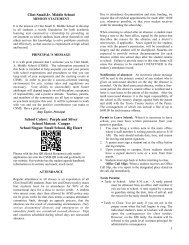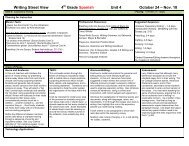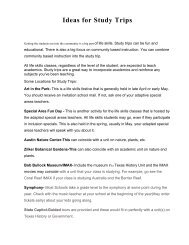Detailed Writing Lessons for The Personal Narrative
Detailed Writing Lessons for The Personal Narrative
Detailed Writing Lessons for The Personal Narrative
You also want an ePaper? Increase the reach of your titles
YUMPU automatically turns print PDFs into web optimized ePapers that Google loves.
<strong>Detailed</strong> <strong>Writing</strong> <strong>Lessons</strong> <strong>for</strong><strong>The</strong> <strong>Personal</strong> <strong>Narrative</strong>Day 1: Starting the <strong>Writing</strong> Workshop, Empezar el taller de escritura<strong>The</strong> lessons provided in this resource are adapted from Book 1, Launching the <strong>Writing</strong> Workshop ofUnits of Study <strong>for</strong> Teaching <strong>Writing</strong> Grades 3-5 by Lucy Calkins. This resource has beenprovided <strong>for</strong> all 4 th grade teams at each campus. While this resource is not necessary <strong>for</strong>planning and facilitating the lessons outlined here, you may be interested in referring to theresource <strong>for</strong> examples of teacher language and other ideas. To order additional kits, please visit:http://www.unitsofstudy.com/default.aspTerms Used Throughout this Resource• Cuaderno de escritor: a composition type book that accommodates multi-leveledassignments; used by students to collect ideas <strong>for</strong> writing, store personal entries,gathering memories, keeping occasional assignments, etc. Often travels with studentsduring share/reflect time & to/from home• Portafolio de escritor: a place where students can store completed, cumulative writing.May contain sequence of rough drafts, mentor texts, unit-specific rubrics, collectedmaterials from writing-in-progress folders.• Carpetas para escritura-en-curso: a folder <strong>for</strong> collecting drafts, rubrics, guide sheets, andmentor texts; sometimes, a two-pocket folder containing loose-leaf papers.• Texto mentor: A piece of literature that is chosen and used by an individual to study aparticular genre.• Textos ejemplares o de piedra de toque: previously read texts that the teacher/studentsreturn to over-&-over to teach the craft of writing (ex. Leads, character development,noun/verb agreement, punctuation, etc.) If allowed, teachers sometimes make copies ofpieces of that text <strong>for</strong> which students may refer to as they are writing.Minilesson:1. Name the teaching point by telling students that you will teach them ideas <strong>for</strong>generating personal narratives.2. To get started with selecting what to write about, Teacher poses the followingprewriting topic and writes on a chart: Piensa en una persona que te importe mucho yhaz una lista de momentos pequeños y claros que has tenido con esa persona. Pon momentosque recuerdes con claridad cristalina.3. Teacher models the entire process described above by writing on chart paper orother medium <strong>for</strong> all to see.
Independent <strong>Writing</strong>:4. Explain to the students that what you’ve demonstrated is what they will now do.5. Students think of someone that matters to them and lists on their fingers 2-3 littlemoments they especially remember.6. Students are to zoom in on the most important part and make a thumbnail sketch toquickly show the order of their story.7. Students then tell a partner their story, including all the tiny details.8. Next, students are to return to their writing area and in silence, write the stories theyhave just told.Peer Sharing:9. Convene students in the meeting area and have a quick recap of the expectations <strong>for</strong>peer sharing.10. Have students sit with a partner that has been assigned by the teacher usingnumbered paper (containing 1 and 2 followed by student names.) Students sit kneeto-kneeas they take turns discussing a person who matters to them. <strong>The</strong> intent is tolet students practice the art of establishing partnership conversations.11. Students then recall and share one thing that was learned during the day’s writinglesson with their partners, taking turns so that each has an opportunity to talk.12. Post the Estrategias para generar escritura de narrativa personal chart in a place <strong>for</strong> allstudents to see, as it will be developed over time with the students.Estrategias para generar escritura de narrativa personal• Piensa en una persona que sea importante para ti yluego haz una lista de momentos pequeños y clarosque recuerdas con él/ella. Escoje uno para dibujar yluego escribe la historia acompañante.
Day 2: Generating more writing, Generar más escrituraMinilesson:1. Remind children that today and every day the writing workshop will begin with aminilesson. Remind them of what happens in a minilesson.2. Name the teaching point by telling students that you will teach them a secondstrategy <strong>for</strong> generating ideas <strong>for</strong> personal narratives.3. Teacher poses the following prewriting topic and adds it to the chart: Piensa en unlugar que te sea importante, luego haz una lista de momentos pequeños y claros querecuerdas haber pasado ahí. Escoje uno para dibujar y después escribe la historiaacompañante.4. If possible, teacher shows students an exemplar or touchstone text that centersaround a place. Teacher then talks about how the author might have used thatstrategy to get an idea about what to write and then of episodes that have happenedin that place. It is important to choose just one episode to write about.5. Teacher and students think of a place that matters to all (example: playground,cafeteria, library, etc.)6. Together, they generate a list of small moments that happened in that place.7. Students choose one idea and partner-share their stories orally.Independent <strong>Writing</strong>:8. Students are sent to their writing spots where they quietly begin to write.9. After they have been writing awhile, teacher stops the class <strong>for</strong> a mid-workshopteaching point. Teacher says, Piensa en un lugar que te sea importante, luego haz unalista de momentos pequeños y claros que recuerdas haber pasado ahí. Escoje uno paradibujar y después escribe la historia acompañante.10. Teacher models by providing his/her own special object and does a “think- aloud”based on the memory that object sparked.11. Teacher adds this new strategy to the chart and reminds students that writers canuse any of these strategies when they finish one entry to be able to start anotherentry.12. Students return to the entry in progress.Peer Sharing:13. Gather whole group (sitting with a writing partner) to sum up, share, andcelebrate. Remind students that we are working on writing quickly and <strong>for</strong> longerperiods of time, much the same as runners do as they often push themselves to runfarther and faster.
14. Teacher poses the following question, ¿Qué puedes hacer para es<strong>for</strong>zarte como escritor,como algunas personas se esfuerzan para ser corredores atléticos? Habla con tu compañerode tus planes para es<strong>for</strong>zarte para escribir más.15. Teacher circulates and makes notes on some of the conversations s/he heard.16. Reconvene group and discuss some of the thoughts students expressed. <strong>The</strong> intentis to help students identify ways they can begin to build stamina <strong>for</strong> writing.Estrategias para generar escritura de narrativa personal• Piensa en una persona que te importe mucho y haz una lista demomentos pequeños y claros que has tenido con esa persona.Pon momentos que recuerdes con claridad cristalina.• Piensa en un lugar que te sea importante, luego haz una listade momentos pequeños y claros que recuerdas haber pasadoahí. Escoje uno para dibujar y después escribe la historiaacompañante• Fíjate en un objeto y deja que ese objeto te recuerde a una memoria.Escriba la historia de ese episodio.Day 3: Qualities of Good <strong>Writing</strong>: Focus, Detail, and StructureCaracteristicas de buena esritura: enfoque, detalle y estructuraMinilesson:1. Tell children that today’s teaching point will begin with focus.2. Teacher explains that when we think of a topic and then list specific instances,sometimes those specific instances are still too big.3. Writers know that to write a story that draws readers close to listen, it helps to writeabout a small episode, something that happened in twenty minutes, or even in justthree minutes! It is important to zoom in on one small story and to tell the parts ofthe story that matter, leaving out sections that don’t matter. Writers retell thesequence of events in our stories, writing with details, telling the story in a step-bystepway.4. Teacher creates a chart titled Caracteristicas de buena escritura de narrativa personal andposts it <strong>for</strong> all to view.
Caracteristicas de buena escritura de narrativapersonal• Escribe un cuento pequeño ‘semilla,’ no escribas deun tema enorme ‘sandía.’• Enfócate a contar las partes más importantes delcuento.5. Together, discuss how the first bullet point helps us think about not only what we’regoing to write about but also how we’ll write our stories so that they really affect ourreaders. Normalmente cuando pensamos en una persona, un lugar o un objeto, por ejemplo,lo que nos viene a la mente primero son tremendos temas de tamaño sandía. Para escribiruna historia muy buena, nos ayuda seleccionar un asunto más pequeño y especial y no contarun relato sandía sino que un cuentito semilla. Teacher provides explicit models todemonstrate the difference between sandía topics and semilla stories.Ideas posibles para distinguir entrela idea sandía vs. la idea semilla:• Ratos divertidos que paso con mi perro (sandía)• Cuando ví por primera vez a mi perro en la perrera y me dícuenta que era el perro para mi(semilla)• Cuando la persona que ahora es mi mejor amigo llegó anuestro salon de clase y nos conocimos por primera vez(semilla)• Mi mejor amigo (sandía)• El año que estuve en el equipo de futból y ganamos seispartidos y perdimos dos (sandía)• La vez que Susan y yo encontramos una moneda de 25centavos que estaba congelada en hielo y la desconchamos(semilla)6. Students will practice distinguishing between big topics and focused stories. Teacherwill provide a series of ideas and ask students to identify either sandía or semillastory.7. Together with a writing partner, students look over the entries in their notebooksand identify “cuento sandía” or “cuento semilla.”8. Encourage those students who have written temas sandía to look <strong>for</strong> possible cuentossemilla within.
Independent <strong>Writing</strong>:9. Students explore and develop their identified cuentos semilla stories from any largertopics they may have written (temas sandía).Peer Sharing:10. Convene the group and have students sit with a writing partner.11. Students share any additions they have made and Teacher notes possible exemplarsof students who have developed a seed story.12. Begin a discussion about what to do when you think you are finished writing.13. Teacher scribes ideas as students discover ways to extend their writing. Continueto add as students come up with additional ideas.Cuando haya acabado• Al acabar una anotación, debo empezar otra porquealgunas de mis anotaciones son muy cortas.• Regresar a una que ya halla escrito para ver si puedoenfocarme más en el tema.• Pasar menos tiempo hablando y más tiemporedactando.• Volver a mi lista de ideas anotadas y agregar másmomentos.•
Day 4: <strong>Writing</strong> with Specific Details, Escribir con detalles específicosMinilesson:1. Tell children that today’s teaching point will begin with writing with specific details.2. Teacher selects an exemplar from the class that shows how a student extendedhis/her own writing by telling exact details. As a result, the student may havecreated a movie in his/her head.3. Teacher provides a specific example to help students understand this idea. Onepossible idea might be to show how a photographer zooms in on one tiny part of alarger picture. For example, instead of photographing a whole meadow, aphotographer might just zoom in on three daisies within that meadow.4. Students work with a writing partner to check <strong>for</strong> places in their own writing wherethey could apply this technique of using exact details.Independent <strong>Writing</strong>:5. Students return to their writing area and work on adding exact details to theirwriting.6. Teacher circulates and provides support as needed, reminding students that “truedetails” do not need to have specifically occurred in the event, but if they makesense in the context of the story, the author has the license to include them.Peer Sharing:7. Teacher adds to the criteria chart and reminds students to use this chart periodicallyin their writing to extend their sentences.8. Students share with a writing partner the places where they have added exact details.Caracteristicas de buena escritura de narrativapersonal• Escribe un cuento pequeño semilla, no escribas de untema enorme sandía.• Enfócate a contar las partes más importantes delcuento.• Incluye detalles verídicos* y exactos de la películaque tienes en la mente.* (Detalles no tienen que haber sucedido específicamenteen el acontecimiento, y el autor tiene la libertad deincluirlos si fueron realistas).
Day 5: <strong>The</strong> Writer’s Job in a Conference, La tarea del escritor en unaconferenciaTeachers tend to ask the following questions during a conference. This lessonprepares students to answer them.ooo¿En qué estás trabajando como escritor?¿Qué pretendes lograr como escritor?¿Qué harás hoy en cuanto a tu escritura?Minilesson:1. Tell children that today’s teaching point will center on the writing conference andthe structure in which they will be participating.2. Teacher explains that during the writing conference, the child’s job will be to talk tothe writing teacher about their thinking.3. <strong>The</strong> teacher will want to know what they are trying to do as a writer, what they’vedone so far, and what they are planning to do next.4. <strong>The</strong> teacher will begin the conference by interviewing the writer, asking questionsabout their writing (not their topic).5. <strong>The</strong> teacher’s job will be to observe writing behaviors that will move the writing<strong>for</strong>ward.6. Set children up to practice their roles in the conference by asking questions youmight ask of the writer. <strong>The</strong> student’s role will be to think about the answer, andlook to the charts posted if unsure what to say. For now, the conference will be a“thinking” one and will not be shared orally as students practice how to focus onthe specific questions.7. Teacher poses the following question and allows students thirty seconds to silentlyanswer the question: ¿En qué estás trabajando hoy como escritor?8. Students turn and talk to their writing partner about what they are thinking. Afurther question might be posed: ¿Qué pretendes lograr como escritor?9. Teacher pulls group back together and asks students to consider the followingquestion silently <strong>for</strong> thirty seconds and then to share with their partner: ¿Qué haráshoy en cuanto a tu escritura?Independent <strong>Writing</strong>:10. Students go to their writing area and work on adding exact details to their seedstory. If students finish one story, remind them that they can add exact details toanother seed story. Remind them of your ‘When I’m Finished’ chart.
Peer Sharing:11. Students listen to and think about their partner’s writing and name what isworking well in it. (Partner 1 reads what they wrote today, while partner 2 talksspecifically about what worked well and where this occurred). Repeat <strong>for</strong> secondpartner.Teacher Tip: Sometimes students write a summary instead of a story. To helpwith this, suggest that students make a movie in their mind detailing exactly,¿Qué pasó primero? ¿En dónde estaba yo? If the partners decide that the entry isnot yet a story, consider having the writer start again, telling exactly whathappened first and then next.Day 6: Building Stories Step-by-Step, Crear cuentos paso a pasoMinilesson:1. Explain that personal narratives are often organized chronologically, told as asequence of events and not a description of events.2. Model what it means to storytell an event. For example, instead of: Fuí a nadar con mimejor amigo. Hacía calor. Me enseñó cómo hacer una marometa hacia atrás. Una narrativapersonal diría, El sábado Juan y yo pasamos todo el día en la piscina de la comunidad.Cuando ya no podíamos pensar en ningún otro juego que jugar, Juan me preguntó,”¿Sabesdar una marometa hacia atrás debajo del agua3. Explain that writers tell their stories step-by-step, getting the memory in their headand then thinking, ‘¿Qué sucedió primero, y luego, y luego.’4. Model telling a story step-by-step using one of your own stories.5. Ask students to turn to a partner and storytell an event. For this practice, choose anevent they all have in common, like a fire-drill.6. Listen in as students tell each other the story.7. Highlight the storytelling of a couple of students who resisted describing the eventand instead told the story step-by-step.
Independent <strong>Writing</strong>:8. Restate the goal <strong>for</strong> today. De ahora en adelante, cuando escribas un relato, no sólo hablesde todo lo que pasó, sino que describe lo que sucedió primero, y luego y luego. Empieza hoycon leer otra vez tus cuentos de ayer y asegúrate que los has contado como historias.9. Students will continue to work in their Cuadernos de escritor.Peer Sharing:10. Ask one or two students who wrote their stories step-by-step to share their work with theclass. Ask students, ‘Qué hicieron estos escritores que hacen todos los escritores?’Teaching Tip: For students who struggle with oral storytelling or with sequencing events, youcould offer them the option of creating a storyboard to help them move through their narrativestep-by-step. You could create a template that looks like this:Carefully consider which students would benefit from using this template. For some students,doing so will only delay their drafts; <strong>for</strong> others, the necessity of doing so will support theirdrafts.
Day 7: Choosing a Seed Idea, Escoger una idea semillaIn this lesson you will be solidifying the foundation <strong>for</strong> writing focused piecesthroughout the year. You’ll want to consider how to make this conversationpublic in order to continue to build on these ideas later.Teaching Tip: Today represents a change <strong>for</strong> your students as writers. For thefirst time this year they will be taking one small idea – a semilla idea – andthinking about how to turn it into a complete story <strong>for</strong> publication. This willbe a good time <strong>for</strong> you to take stock of your students as writers, considering:What seems to be getting better? What hasn’t changed?As you review the work in your students’ writer’s notebooks, try to make bothgeneral observations about your students as a whole and observations specificto small groups or individual students. Find a way to record yourobservations so that they can guide your whole group instruction and yourindividual conferences with students.Minilesson:1. Tell students you’ll teach them to choose one entry to develop into a publishablepiece. Hoy quiero enseñarles que los escritores no solo escriben una anotación y luegoescriben otra y otra como hemos estado haciendo nosotros. Como escritores, después derecopilar apuntes e ideas por un tiempo, leemos todo de nuevo y encontramos un cuento, unaanotación que nos sea importante y nos comprometemos a esa anotación en particular.Decidimos trabajar en ella hasta que sea nuestra mejor redacción hasta ahora.2. Using Roxaboxen or any favorite narrative text as a reference, explain to the studentsthat writing allows authors: a tomar todas las cosas que están a su alrededor – los cuentospequeños – y tomar un pedacito de la vida en sus manos, declárandolo un tesoro.Teaching Tip: It is not necessary to use the exact text mentioned above <strong>for</strong> thislesson. Select any favorite narrative text that illustrates the idea of smalltreasures all around us – the stories of our lives – that can be used to write apublishable piece.3. Model how you go back to your entries and you reread them and think aboutwhether one of your entries might be worth developing into a story that you’d like topublish.4. Ask students to tell their partner three specific things they saw you doing in order tochoose an entry that mattered to you.
Independent <strong>Writing</strong>:5. Restate the goal <strong>for</strong> today’s writing time: Hoy, y cuando sea tiempo de dejar de juntaranotaciones y de empezar a trabajar en un sólo projecto de redacción, recuerda que tú, - comolos escritores en todas partes – puedes volver a leer tus Busca anotaciones que te atraigan, queparecen estar diciendo,’¡Escógeme a mí!’Escoger una idea semilla• Con cuidado lee de nuevo todas tus anotaciones.• Pregúntate, ‘¿Esto es verdaderamente importante parami? ¿Dice algo de mí?’• Coloca una estrella al lado de las anotaciones queparecen ser posibilidades.• Repasa las anotaciones con estrellas y escoje la que tedice‘¡Escógeme!’• Escoje la anotación de la cual tienes mucho que decir.6. Students work in their Cuadernos de escritor to choose a semilla idea to develop intoa published piece.Closing:7. Provide time <strong>for</strong> students to read books and stories that remind them of what theywant to write.Con tu idea semilla en mente, toma el tiempo de leer uno de estos libros. Leélo y vuelve a leerlohasta que tengas el sonido y el sentimiento en el alma . Siente el tono y la <strong>for</strong>ma. Querrás sentireso para que puedas recrearlo en la anotación que has elegido.o Collection of mentor texts about seed moments.Possible examples might include:• Emily by Michael Bedard• <strong>The</strong> Sleeping Porch by Karen Ackerman• <strong>The</strong> Sunsets of Miss Olivia Wiggins by Lester Laminack
Day 8: Revising Leads: Learning from Published <strong>Writing</strong>,Revisar entradillas: aprendiendo de las escrituras publicadasMinilesson:1. Tell students that writers improve leads by studying the work of authors and thenapplying their techniques.2. Explain that leads in stories matter not only <strong>for</strong> the reader, but <strong>for</strong> the writer as well.Una excelente entradilla nos pone (los escritores) en una buena posición para escribir uncuento estupendo.3. Discuss with students ways that writers can improve their leads – reading beautifulleads written by other authors and closely examining their work. Writers can askthemselves: ¿Precisamente qué ha hecho éste autor que yo podría intentar?4. Demonstrate or model how to study the work of mentor authors. Think aloud asyou study the lead of a mentor author and say, Observa cómo estudio la entradilla de(autor) de (título del libro). Read and then reread the lead quietly. <strong>The</strong>n say, Lo leí unavez, después lo volví a leer. Estoy tratando de entender el sentimiento de la entradilla. Estoypensando, ¿Qué ha hecho (el autor) que yo podría hacer? La primera cosa que me llama laatención es…5. Chart the elements the mentor author included. <strong>The</strong>y might include: main characterdoing a specific action, main character saying or thinking something, anothercharacter doing an action.6. Model taking what you’ve noticed and applying it to your own story or a class story,being explicit about what and how you are revising. You might say, Decidí agregaruna acción y una visión más clara del escenario a mi entradilla.7. Share a lead written by one student.8. Ask children to revise the lead out loud with a partner.Independent <strong>Writing</strong>:9. Restate the teaching point. Cuando regresen a sus mesas para escribir, piensen en lo quehan aprendido de redactar entradillas y luego pongan en prueba tres o cuatro entradillas ensus cuadernos. Empiezen con el escenario o acciones o diálogo o una combinación de estos.Peer Sharing:10. Name what you hope that your students learned from the demonstration on leads.Add this lesson to the Caracteristicas de buena escritura de narrativa personal chart.11. Share the work of one or two students who wrote several possible leads
Caracteristicas de buena escritura de narrativapersonal• Escribe un cuento pequeño semilla, no escribas de untema enorme sandía.• Enfocate a contar las partes más importantes delcuento.• Incluye detalles verídicos y exactos de la película quetienes en la mente.• Comienza con una entradilla fuerte – tal vez utiliza elescenario, acción, diálogo para crear el tono.Day 9: <strong>Writing</strong> a Draft, Redactar un borradorIn this lesson, teacher will show students that one way writers draft is by writingfast and long in order to get a whole story down on paper as it comes to mind.Minilesson:1. Explain to students that there are some kinds of writing that you have to do veryfast. Like riding a bicycle, to stay up, we need to pedal fast and go full speed ahead.In order to tell a whole story and make listeners feel what we want them to feel, ithelps to write fast and long. Hoy escribiremos los mismos cuentos que nos contamos eluno al otro… sólo que mejor!2. Explain that when drafting, students will use loose-leaf notebook paper, write ononly one side, and skip lines.Independent <strong>Writing</strong>:3. Students reread the lead that they wrote in their writer’s notebooks.4. Take out loose-leaf notebook paper <strong>for</strong> writing the story. Students touch the pages asthey tell the whole story, spreading across pages, and then go back to page one.
8. Students work quietly rereading and marking important actions, words, images thatcould maybe be woven into the final scene or image. Have students try severalendings <strong>for</strong> their piece (important action, dialogue, images).Peer Sharing:9. Name what you hope that your students learned from the demonstration onendings. Add this lesson to the Caracteristicas de buena escritura de narrativa personalchart.10. Share the work of one or two students who wrote several possible endings.Teaching Tip: It is not necessary to use the exact text mentioned above to learnabout writing endings. Select a narrative text with which children are alreadyfamiliar and that has an ending that is succinct and memorable and has movesin it that children can see. Do not only read the last line of the text. Usually anauthor regards both the lead and the ending of the story as longer than one ortwo lines.o Try a mentor text, such as Fireflies! By Julie Brinckloe.Caracteristicas de buena escritura de narrativa personal• Escribe un cuento pequeño semilla, no escribas de un temaenorme sandía.• Enfocate a contar las partes más importantes del cuento.• Incluye detalles verídicos y exactos de la película quetienes en la mente.• Comienza con una entradilla fuerte – tal vez utiliza elescenario, acción, diálogo para crear el tono.• Crea un final fuerte – tal vez utiliza importantes acciones,diálogo, imágenes o recordatorios del cuento entero quecausen una impresión duradera.Teaching Tip: As you read your students’ writing, checking conventions,determine areas of need <strong>for</strong> future mini-lessons: punctuation, consistent tense, etc.
Day 11: Starting a Second Piece, Empezar una segunda obraMinilesson:1. Celebrate your students’ rough drafts!2. Name the teaching point: Algunos de ustedes han terminado sus borradores mientrasque a otros les falta mucho que escribir. De cualquier modo, no deberían de tener que<strong>for</strong>marse ante mi escritorio para preguntarme,”¿Y ahora qué hago?” Ustedes están al cargode su escritura- los escritores toman sus propias decisiones de escritura.3. Explain that only each writer can decide when a story is done. In the next week, allstudents will write a second story; some starting today, and some tomorrow or thenext day. Después que cada estudiante haya escrito dos relatos, veremos los dos yescogeremos el que más nos guste para revisarlo de nuevo, editarlo y publicarlo.4. Explain how to chart to keep tabs on progress through the writing process.Monitoreando mi proceso de escrituraColectar anotacionesSeleccionar y desarrollar una idea semillaContar un relato para ensayar antes deescribirLeer textos mentorRedactar entradillas – prueba con acciones,diálogo…Escoger papel, planear en varias paginas,copiar la entradillaEscribir borrador con cada parte en hojasseparadasReleer y revisar para claridadRedactar el final – acciones importantes, etc.Corregir y editar ahora o esperar hasta mástarde1 aobra2 aobraTeaching Tip: Make sure the language you use on your Monitoring My <strong>Writing</strong>Process chart matches the language you’ve been using to explain each step in theunit on personal narrative.
Independent <strong>Writing</strong>:5. Students decide where they are in the process: Antes de que comenzemos a escribir hoy,piensa en cómo vas progresando. Repasa tu carpeta y pregúntate cuales pasos ya has hechopara tu primera obra. ¿Necesito usar mi cuaderno de escritor para comenzar una segundaobra? Teacher circulates to confer and assist.Peer Sharing:6. Ask students to examine their work <strong>for</strong> examples of some qualities of good writingfrom the class chart.7. Ask a few students to share what they are doing that is working well.Teacher Tip: Be sure to share exemplar (or touchstone) texts during read aloud.Point out places that these expert authors exemplify the Caracteristicas de buenaescritura de narrativa personal.
Day 12: Timelines as Tools <strong>for</strong> Planning Stories,Cronologías como herramientas para planear relatosMinilesson:1. Tell students that you will teach them another strategy <strong>for</strong> developing a story idea:making timelines.2. Model strategy by making timeline with your own writing idea.3. Explain how making a timeline helps to set parts of the story in order. <strong>The</strong> timelinecan be used to remind us what happened first, second, next, and after that.Example Timeline:• Lunch• Brought frisbee to yard• Threw frisbee• Mud puddle• Bee drowning• Saved bee• Bee stung me• Stepped on bee• Ran away• Got frisbeeIndependent <strong>Writing</strong>:4. Set students up to try the strategy. Have them recall an event the class experiencedtogether; help them make their own timelines of that event.Peer Sharing:5. Celebrate that they are imagining starting points <strong>for</strong> their second piece of writing.6. Add this new strategy to the Monitoreando mi proceso de escritura chart.
Monitoreando mi proceso de escrituraColectar anotacionesSeleccionar y desarrollar una idea semillaContar un relato para ensayar antes de escribirLeer textos mentorRedactar entradillas – prueba con acciones,diálogo…Escoger papel, planear en varias paginas, copiar laentradillaEscribir borrador con cada parte en hojas separadasReleer y revisar para claridadRedactar el final – acciones importantes, etc.Corregir y editar ahora o esperar hasta más tardeCrear una cronología1 aobra2 aobra7. Explain that timelines can be used to help Writers focus and revise our writingbe<strong>for</strong>e it is even written. Give an example… Al darme cuenta de lo que realmentequiero enfocarme en mi relato, puedo tachar la parte del almuerzo. No es importante para elcuento. Ask students to consider revising the timeline of the class’ story.Day 13: Timelines as Tools <strong>for</strong> Planning Stories,Cronologías como herramientas para planear relatosMinilesson:1. Remind students that yesterday we learned that writers can get ready to draft storiesby making timelines. This helps to tell the order of events. We can also cross outparts that are not important to the story be<strong>for</strong>e we begin to write.2. Name the teaching point: Los escritores también pueden analizar un sólo punto en lacronología, expandiendo ese sólo punto con su cronología propia.3. Show students an example of a timeline that has been made from a small part ofanother one (from your timeline or from the class).Independent <strong>Writing</strong>:4. Ask students to try this new strategy. Students read over their timelines and choosean important dot to expand upon.5. Partners share the story of just one dot on their timelines so that the partner canmake a movie in his or her mind.
6. Students may choose how to get started or progress with second story and draft.Closing:7. Explain that writers can keep themselves on track by making and sticking to plansand goals. Writers can do this by looking back at first completed piece and bythinking, “What did I do in this piece that I want to always do as a writer?” (Sharesome strategies used by some of your students.)8. Get with partners, look over each other’s first pieces, and create some goals <strong>for</strong> yourfuture writing, starting with this piece.Day 14: <strong>Writing</strong> From Inside a Memory, Escribir de por dentro de unamemoriaMinilesson:1. Review with students that writer’s don’t just sit down in front of a blank sheet ofpaper, pick up a pencil, and write. Instead, as writers, we live in a way that gets usready to write. We look <strong>for</strong> possible stories, gather entries, then select an entry thatmatters to us, storytell to our friends and ourselves, and draft and revise timelines ofthe story sequence. We often explore different leads and plan how our story will layout across pages.2. Name the teaching point: Hoy quiero enseñarles que para escribir narrativas personalesbien, hay que vivi de nuevo acontecimientos de nuestras propias vidas.3. Point out to students that we all have memories (good and bad) that are seared intoour minds <strong>for</strong>ever and give some examples. As writers, we can go back and relivenot only life-changing events, but also small moments that <strong>for</strong> some reason reallymatter.4. Model how you write by reliving. Voy a cerrar los ojos y pensar profundamente en unamemoria. Recuerdo exactamente en dónde yo estaba…Independent <strong>Writing</strong>:5. Ask students to try this strategy by reliving an important moment from the daybe<strong>for</strong>e and write it down as they lived it. Have one student share or the teacher canshare one student’s writing as an example.6. Give students some time to think and write.
Peer Sharing:7. Students share what they wrote with partners. Allow a few students to share withthe group, if time.8. Add to the criteria chart Caracteristicas de buena escritura de narrativa personal.Caracteristicas de buena escritura de narrativa personal• Escribe un cuento pequeño semilla, no escribas de un temaenorme sandía.• Enfócate a contar las partes más importantes del cuento.• Incluye detalles verídicos y exactos de la película que tienes enla mente.• Comienza con una entradilla fuerte – tal vez utiliza elescenario, acción, diálogo para crear el tono.• Crea un final fuerte – tal vez utiliza importantes acciones,diálogo, imágenes o recordatorios del cuento entero que causenuna impresión duradera.• Revive el acontecimiento mientras lo escribes.Teaching Tip: Keeping charts alive in the classroom is very important. It’s notenough to hang them on the walls and expect students to look at them or use them.<strong>The</strong> more a chart is referred to, the more likely it will be used by the students.
Day 15: Paragraphing to Support Elaboration,Dividir en párrafos para apoyar el desarrollo de ideasMinilesson:1. Celebrate how the students are writing from inside their stories (reliving) and notsummarizing from a distance.2. Explain how writers use paragraphs to group ideas in their stories. For example,each dot on the timeline is probably one grouping or one paragraph. Teacher sharesan example of her writing on chart tablet divided into paragraphs. Explain thatfrom now on, as they write, they will chunk their stories into paragraphs.3. Set children up to practice the strategy on a class text with partners.Independent <strong>Writing</strong>:4. Ask students to reread their drafts and draw a box around the sentences that go in achunk. Explain that when they make the next draft, they can put in the paragraphs.5. Students continue to draft.Peer Sharing:6. Gather whole group to share and reflect on successful uses of this minilesson.7. Show an example of a student’s writing who used paragraphing.
Day 16: Paragraphing to Support Elaboration,Dividir en párrafos para apoyar el desarrollo de ideasThis is the second of two lessons on paragraphing. As the writers in yourclassroom develop, you will want to revisit this lesson throughout the year, inorder to layer on specific times when paragraphing is needed (change of place,time, speaker, etc…) and to support sequence and summary in reading.Minilesson:1. Point out that many of the students’ paragraphs are tiny, a signal that their piecesare underdeveloped.2. Name the teaching point: Tell students that tiny paragraphs signal a need <strong>for</strong>elaboration. Esto significa que necesitas decir más sobre un asunto, un momento, unaescena antes de avanzar al próximo párrafo. Es buenísimo desarrollar en el primer borradorsegún vayas escribiendo, pero también puede ser que cuando revises un borrador completo tedés cuenta que hay partes dónde necesitas decir más.3. Teacher models how to add ideas and elaborate a paragraph of her writing.4. Set students up to practice the strategy on a class text with partners. (Ask a student’spermission if using a piece of writing.)5. Partners read over the draft and think about the elements of effective narrativewriting. ¿La obra incluye diálogo? ¿Acciones pequeñas? ¿Pensamientos? ¿El escenario?Si puedes descubrir lo que falta, entonces sabes una manera de ampliar. Los compañeroshablan de lo que se puede añadir.Independent <strong>Writing</strong>:6. When students write today, ask them to remember to elaborate on their sentencesand paragraphs by adding actions, dialogue, descriptions, and thoughts.Peer Sharing:7. Remind students of the day’s teaching on elaboration. Invite students to share anexample of elaboration.Teaching Tip: As you confer with students, prompt them to elaborate andrevise by asking questions, such as “What’s the most important part of thisstory? What’s the heart of this story?” Have students reread drafts to answerthese questions.
Day 17: Revision: Developing the Heart of a Story,Revision: Desarrollar lo esencial de un relatoMinilesson:1. Remind students of the work they’ve been doing; rally their energies towardrevision.2. Name the teaching point: Revision is not about fixing errors; it is about finding anddeveloping potentially great writing, sometimes by adding more to the heart of thestory.3. Students will reread both pieces they have written and decide which one has specialpromise; and that is the piece that will be revised and published.4. Spotlight what one student did (as you conferred yesterday) in a way that illustratesthe teaching point. Retell the story of that process pointing out what the student didto find and develop the heart of her story.5. Practice this work on a class story. Reread. Piensa y díle a tu compañero en dóndepuede estar ‘el corazón’ del relato para ti. Haz una película en tu mente de lo que pasó en esaparte y dile a tu compañero cómo alargarías esa parte.Independent <strong>Writing</strong>:6. Students return to their chosen draft to make their story the best in the world.Peer Sharing:7. Highlight a student who took the minilesson to heart. Tell the story of that student’swork in a way others can learn from.
Day 18: Using Editing Checklists, Usando listas de control para editarMinilesson:1. Explain to students that there are many self-help books published, such as How toBecome a Millionaire, How to Win Friends and Influence People, etc. Tell studentsthat it is time <strong>for</strong> the part of the writing process called editing and that they deservea self-help text that can act as a personal coach on editing.2. Name the teaching point: Writers use editing checklists to remind us of strategieswe can use to edit our writing. (attached)3. Distribute editing checklists <strong>for</strong> students to keep in their writing folders.4. Teacher uses chart-sized editing checklist to explain the process to the students.Independent <strong>Writing</strong>:5. Students read through their drafts with partners, focusing on one item on thechecklist.6. Ask students to reflect on the editing process. Students will then ask a writingbuddy to help edit. Students exchange papers and be another pair of eyes <strong>for</strong> theirpartners. Have students select a different color pen or pencil and put on their best‘editing glasses’!Teaching Tip: Using a different color pen or pencil, or one with a special flair toit, can be a tool that inspires editing: a fancy editing tool can spark kids to makechanges just <strong>for</strong> the thrill of using it – especially when it comes to correctingspelling and punctuation.Teaching Tip: At some point, the students will need to assess their writing anddecide which editing tasks they need to add to their own editing checklists. <strong>The</strong>checklist is also a place you can add items you and the child discuss inconferences and strategy lessons. This helps to hold the student accountable <strong>for</strong>all of the minilessons taught.
Nombre_______________________________ Fecha_________________________Título: _______________________________ Unidad de estudio: _________ _____________Vuelve a leer tu escritura cuidadosamente. Marca cada casilla bajo “Autor” cuando completescada punto de revisión. Una vez que todas las casillas estén marcadas, da esta lista de control a laprofesora para la edición final.Lista de control para edición Autor Maestra/o1. Claridad – Leéla, preguntándote, “¿Tendría sentido esto paraalguien desconocido? Busca partes confusas y vuelve a redactarlaspara hacerlas más claras. Fíjate en partes dónde te trabas un pococuando relees y revísalas para hacerlas más faciles de leer.2. Puntuación – Lee, pon atención a las ‘señas de tráfico’ que has dadoa los lectores. Si siguieras la punctuación que tú mismo has colocado,la obra sonaría cómo quisieras que sonase? ¿Has evitado frases que seprolongan demasiado? ¿Has puntuado el diálogo?3. Ortografía - ¿Te parece que las palabras estan bien deletreadas?Pon un círculo alrededor de las que pueden estar equivocadas,inténtalas otra vez, solicita ayuda. Revisa que las palabras en la paredde palabras estén bien deletreadas.4. Párrafos – Los escritores de narratives usan un nuevo párrafo o unapágina nueva para cada acontecimiento en la cronología de eventos.¿Empleas los párrafos para indicar el paso el tiempo? ¿También usaslos párrafos para mostrar cambios en el hablante?Artículos opcionales:PuntuaciónPara los que estén pasando dificultades...¿He escrito con períodos yletras mayúsculas? ¿Evito el uso excesivo de y o así que paracombinar muchas frases cortas en una frase demasiado larga?Para los escritores con mayor experiencia...¿He usado puntuacióncompleja y frases variadas para ayudar a los lectores a leer mi relatocon expresividad y de tal manera que se crea el ambiente que pretendocrear? ¿He usado un autor mentor para darme ideas de cómo usar lapuntuación en <strong>for</strong>mas nuevas para crear un efecto impactante en partede mi relato?OrtografíaAl descifrar palabas largas y difíciles, he tratado de grabar cada sonidoque oigo en la palabra? ¿He usado lo que sé de cómo se deletreanotras palabras para ayudarme a deletrear partes de la palabra difícil?¿He releído mi ortografía y puesto círculos alrededor de las partes delas palabras que sospecho podrían estar equivocadas? ¿He utilizadolos deletreos que ya conozco (especialmente aquellos en la pared depalabras) para ayudarme descifrar las palabras que desconozco?—from Lucy Calkins’, Resources <strong>for</strong> Teaching <strong>Writing</strong>
Day 19: Publishing: A <strong>Writing</strong> Community CelebratesLa publicación: festeja una comunidad de escrituraAs you decide what Author Celebrations will look like in your classroom,consider these things:• Would invited guests provide a purpose <strong>for</strong> reading the published piecesaloud?• Will every student read their piece aloud <strong>for</strong> the whole audience or willstudents read to small groups?• Will the celebration include refreshments?• If there will be an audience, should they be given a purpose <strong>for</strong> listeningto and commenting on the stories?• How will the work that is celebrated today, be shared with a greateraudience?An Author’s Celebration – <strong>The</strong> First of the Year!1. This first celebration should make your writers feel proud of what they haveaccomplished and should strengthen their motivation <strong>for</strong> writing.2. Plan to celebrate children’s change into writers rather than celebrating exquisitewriting. <strong>The</strong> children’s work should stand as examples of their best work so far.One Way to Organize the Celebration:3. Set-up four sharing stations in your classroom that will accommodate one author’schair and 8-10 audience members.4. Bring guests into the room and explain the structure <strong>for</strong> the celebration, comparingit to a reading you’ve attended at a bookstore.5. Explain that at each sharing station 5-6 authors will be sharing their stories and willbe available to answer 1-2 questions about their life as writers from the audience.Making the Celebration Public:6. With your writers, you can prepare a Bulletin Board to display their work <strong>for</strong> thewhole school to enjoy.7. Students can be given stickers or crayons to decorate their pieces be<strong>for</strong>e they areposted on the board.



